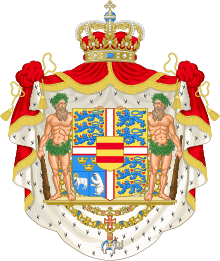Knud, Hereditary Prince of Denmark
| Prince Knud | |||||
|---|---|---|---|---|---|
| Hereditary Prince of Denmark | |||||
 Knud in 1935 | |||||
| Born |
27 July 1900 Sorgenfri Palace, Lyngby-Taarbæk, Copenhagen, Denmark | ||||
| Died |
14 June 1976 (aged 75) Copenhagen, Denmark | ||||
| Burial | Roskilde Cathedral | ||||
| Spouse | Princess Caroline-Mathilde of Denmark | ||||
| Issue |
Princess Elisabeth Count Ingolf of Rosenborg Count Christian of Rosenborg | ||||
| |||||
| House | Glücksburg | ||||
| Father | Christian X of Denmark | ||||
| Mother | Alexandrine of Mecklenburg-Schwerin | ||||
| Religion | Church of Denmark | ||||
Knud, Hereditary Prince of Denmark (Knud Christian Frederik Michael; 27 July 1900 – 14 June 1976), was the second son and younger child of Christian X and Alexandrine of Mecklenburg-Schwerin.
From 1947 to 1953, he was heir presumptive to his older brother, Frederick IX, and would have succeeded him as king had it not been for a change in the Danish Act of Succession that replaced him with his niece, Margrethe II.
Early life and marriage
Prince Knud was born on 27 July 1900 at Sorgenfri Palace in Kongens Lyngby north of Copenhagen during the reign of his great-grandfather, King Christian IX. His parents were Christian of Denmark, son of the heir apparent Frederick, and Alexandrine of Mecklenburg-Schwerin. Knud's only sibling, Frederick, had been born one year before him.
Christian IX died on 29 January 1906, and Knud's grandfather succeeded him as Frederick VIII. Six years later, on 14 May 1912, Frederick VIII died, and Knud's father ascended the throne as Christian X.
As was customary for princes at that time, Knud started a military education and entered the naval college. He married his first cousin, Princess Caroline-Mathilde of Denmark, on 8 September 1933 at Fredensborg Palace. She was a daughter of Frederick VIII's son Harald. Knud and Caroline-Mathilde had three children: Princess Elisabeth, Prince Ingolf and Prince Christian.
Heir presumptive
On 20 April 1947, Christian X died, and Knud's brother Frederick succeeded to the throne as Frederick IX. Since Frederick IX had fathered no sons and the Danish Act of Succession at the time followed the principle of agnatic primogeniture, Prince Knud became heir presumptive and next in line to succeed his brother as king.
Frederick IX had, however, fathered three daughters. In 1953, the Danish Act of Succession was amended to follow the principle of cognatic primogeniture. The new law made Frederick IX's thirteen-year-old daughter Margrethe the new heir presumptive, placing her and her two sisters before Knud and his family in the line of succession.
Later life and legacy
King Frederick IX died in 1972 and was succeeded by his daughter Queen Margrethe II. Prince Knud died in Gentofte on 14 June 1976. He was buried at Roskilde Cathedral. His widow died on 12 December 1995.
In 1953 a students home in Copenhagen was named "Arveprins Knuds Kollegium" in honor of Prince Knud. At the time, Prince Knud was protector of Sydslesvigsk Studie- og Hjælpefond (Study and relief fund of Southern Schleswig),(see Danish minority of Southern Schleswig), an area that could be considered the birthplace of the House of Schleswig-Holstein-Sonderburg-Glücksburg, the royal family Knud was a part of.
The Princess Caroline-Mathilde Alps in Greenland were named by the 1938–39 Mørkefjord Expedition in his wife's honour for Prince Knud had been the patron of the expedition.[1]
Issue
- Princess Elisabeth Caroline-Mathilde Alexandrine Helena Olga Thyra Feodora Estrid Margarethe Désirée (born 8 May 1935).
- Prince Ingolf Christian Frederik Knud Harald Gorm Gustav Viggo Valdemar Aage of Denmark (17 February 1940). Lost his title and became Count Ingolf of Rosenborg after marrying without consent to Inge Terney.
- Prince Christian Frederik Franz Knud Harald Carl Oluf Gustav Georg Erik of Denmark (22 October 1942 – 22 May 2013). Lost his title and became Count Christian of Rosenborg after marrying without consent to Anne Dorte Maltoft-Nielsen. He had issue.
Titles and styles
- 27 July 1900 – 27 March 1953: His Royal Highness Prince Knud of Denmark
- 27 March 1953 – 14 June 1976: His Royal Highness The Hereditary Prince of Denmark [2]
Ancestors
References
- ↑ "Catalogue of place names in northern East Greenland" (PDF). Geological Survey of Denmark. Retrieved 18 June 2016.
- ↑ Lademanns Leksikon vol. 14. Lademanns Forlagsaktieselskab. 1985. p. 148. ISBN 87-15-06065-9.
External links
| Wikimedia Commons has media related to Prince Knud of Denmark. |
- Prince Knud at the website of the Royal Danish Collection at Amalienborg Palace
| Knud, Hereditary Prince of Denmark Born: 27 July 1900 Died: 14 June 1979 | ||
| Danish royalty | ||
|---|---|---|
| Preceded by Frederick as Crown Prince |
Heir to the Danish throne 1947–1953 |
Succeeded by Princess Margrethe |
